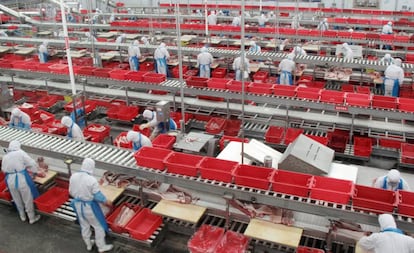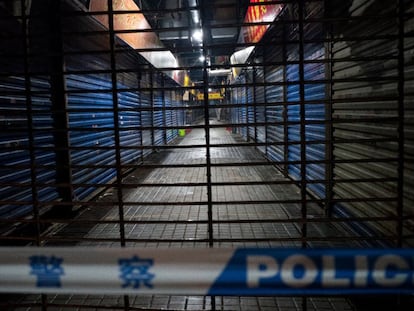China turns to high-rise solution to maintain world’s most voracious pork market
The Chinese dietary staple is of such economic importance to Beijing that the government has encouraged construction of multi-storey buildings dedicated exclusively to pig farming
Six men take the stage, bow to the audience, and place their hands on a huge screen to start a countdown. As it reaches zero, to the rhythm of triumphalist music, images of gigantic buildings follow one after the other; some emerge from the bowels of mountains covered in dense vegetation, others are located on large plains, next to small hills surrounded by forests, some border a lake. These are the vertical farms that China is constructing nationwide for the exclusive purpose of raising pigs, the most popular meat in the country and the supply of which is considered a strategic imperative.
“Why should we promote pig farming in vertical farms? To improve efficiency and reduce costs!” proclaimed the hosts of the presentation delivered at the Third Pig Farming Buildings Forum, held recently in the eastern Chinese city of Qingdao. Protecting and modernizing the pig farming industry is a priority for Beijing, which has accelerated construction of these macro-farms over the past five years to reverse the havoc wreaked by the African swine fever (ASF) epidemic that killed tens of millions of pigs in the country between mid-2018 and 2019 — nearly half of China’s pig population, according to Bloomberg estimates.
“The price of pork skyrocketed in 2018 and that led many investors, especially from the real estate sector, to bet on this industry,” says Wei Jinquan, a representative of Deba Brothers, a supplier of animal husbandry equipment. Zhuge Wenda, owner of a concrete and cement company in Hubei province, is an example of this: he was forced to reinvent his business due to the slowdown in construction activity, so instead of building apartment blocks for humans, he decided to build them for pigs. He is now the chairman and majority shareholder of Hubei Zhongxin Kaiwei Modern Animal Husbandry, a 26-storey, 400,000 square-meter skyscraper that made headlines around the world after its inauguration last October as the largest high-rise farm on the planet. A second identical tower is scheduled to open this year, with the goal of raising up to 1.2 million pigs a year between them.
The enormous building located on the outskirts of the city of Ezhou, on the banks of the Yangtze, is valued at some 4 billion yuan ($582 million) and is one of the most modern macro-farms in all of China — if not the most modern. According to the description available in Chinese media, verified by The New York Times, from a control room staff monitor the animals 24 hours a day and issue food and water preparation orders for each floor, all of which function as an autonomous farm for the different life stages of the pigs; temperature, humidity, ventilation and concentration of toxic gases indicators are also controlled in real time.
The macro-farm is fully automated to increase efficiency: feed is delivered through huge pipes and distributed through automatic feeding points. There are more than 30,000 checkpoints that determine the precise amount of feeding each pig requires, based on the animal’s growth, weight and health. Waste is disposed of through a comprehensive biogas-based treatment system, which converts manure into clean energy.
China, the world’s biggest pork importer
The expansion of China’s mega-farms, which came against the backdrop of the ASF outbreak and the trade war with the U.S., eased after Beijing issued a decree in October 2019 urging all government departments to “stabilize pig production and guarantee market supplies.” To that end, China set a target of 58% of the country’s total pork production coming from macro-farms by 2022, rising to 65% by 2025.
Pork became a staple of the Chinese diet during the drive toward agricultural modernization in the 1970s, but it became hugely popular in the 21st century due to the population’s increased purchasing power. China is now the world’s largest producer and consumer of pork, but also the largest importer. Keeping pork available and at a stable price is of such concern to the authorities that there is a state reserve to maintain supply and boost the market in times of high demand, such as national holidays, or in case of shortages.
Since 2019, procedures for acquiring land for pig farming have been streamlined, the requirement for a special permit to build on agricultural land has been eliminated (provided the factories are intended for the swine industry), and vertical building is permitted to achieve maximum economic benefits. According to the Qingdao forum, by May 2021, 116.8 billion yuan (just over $17 billion) had been invested and 1,832 multi-story farms had been built in 24 of China’s 31 provinces and regions. The largest of these is located in Yuguan, a town in Henan province, covering an area of more than 1,000 hectares with 21 six-floor buildings; its annual production stands at 2.1 million pigs. Unable to compete with these numbers, the trend among small pig farmers has gone in the opposite direction: between 2007 and 2020, the number of farms raising fewer than 500 pigs per year contracted by 75% to 21 million.

Lack of manpower
But the Ezhou skyscraper has its detractors within the industry. “Building such a tall building is not effective, it’s just marketing,” a colleague of Wei’s at Deba Brothers said during his presentation. According to statistics, buildings for pig farming tend to be about six or seven floors high. “There has been a boom in the construction of these buildings in recent years, because people with money wanted to jump on board, but the reality is that there are high-rise farms finished with no pigs inside. If you want to survive in this industry, you have to cut costs. And the more pigs you have, the higher the costs,” Wei told EL PAÍS. According to data shared at the Qingdao forum, only 35% of the total capacity China has constructed for macro-farming pigs is currently in use.
“The biggest challenge we face is that there is not enough labor to go around. Young people think the wages are too low given working conditions on a farm,” says Mr. Liu, a salesman for equipment manufacturer Luohe Green, who adds that, on average, salaries are around $17,500 to $22,000 gross per year. The solution, he says, is to aim for a high degree of automation, which allows a single person to oversee up to 2,000 pigs.
Taking into account the risks that this model of intensive livestock farming entails — such as the rapid transmission of diseases when raising so many animals in an enclosed space — sectorial experts consider these types of structures advantageous because “the problems are clearer, and it is easier to address them.”
“We use intelligent breeding techniques, with a higher level of biosecurity. In addition, regulations require all buildings to have a sanitary inspection module, so we are much quicker and more accurate in detecting possible outbreaks,” says Xu Jin of SEME Construction. Climate change activists say there is little evidence that these production models can bring any sustainability benefits.
In the debates on the subject to which EL PAÍS has had access, the environmental impacts caused by large-scale breeding, such as soil pollution from feces and air pollution from carbon dioxide and ammonia emissions, were barely addressed. On this issue, Xu merely stated that “all our buildings are built in remote areas to comply with environmental laws.” Although China aims to reach a peak in emissions by 2030 — and carbon neutrality by 2060 — the government does not seem willing to accept any opposition to macro farms, viewed by Beijing as the only viable solution to stabilizing the pork market. As of 2019, the Ministry of Ecology and Environment considers that “those who restrict the development of the pig industry or illegally reduce production capacity under the pretext of improving the ecological environment will be investigated and punished.”
Sign up for our weekly newsletter to get more English-language news coverage from EL PAÍS USA Edition
Tu suscripción se está usando en otro dispositivo
¿Quieres añadir otro usuario a tu suscripción?
Si continúas leyendo en este dispositivo, no se podrá leer en el otro.
FlechaTu suscripción se está usando en otro dispositivo y solo puedes acceder a EL PAÍS desde un dispositivo a la vez.
Si quieres compartir tu cuenta, cambia tu suscripción a la modalidad Premium, así podrás añadir otro usuario. Cada uno accederá con su propia cuenta de email, lo que os permitirá personalizar vuestra experiencia en EL PAÍS.
¿Tienes una suscripción de empresa? Accede aquí para contratar más cuentas.
En el caso de no saber quién está usando tu cuenta, te recomendamos cambiar tu contraseña aquí.
Si decides continuar compartiendo tu cuenta, este mensaje se mostrará en tu dispositivo y en el de la otra persona que está usando tu cuenta de forma indefinida, afectando a tu experiencia de lectura. Puedes consultar aquí los términos y condiciones de la suscripción digital.
More information
Archived In
Últimas noticias
Maduro pleads not guilty before the federal court in New York: ‘I am still the president of Venezuela’
A new test can detect Alzheimer’s from a finger prick
UN team enters Sudanese city of El Fasher after paramilitary massacre: ‘It’s like a ghost town’
A recipe for resistance: Indigenous peoples politicize their struggles from the kitchen
Most viewed
- Gilles Lipovetsky: ‘If you want to live better and fall in love, take Prozac, don’t look to philosophy’
- Alain Aspect, Nobel laureate in physics: ‘Einstein was so smart that he would have had to recognize quantum entanglement’
- Alvin Hellerstein, a 92-year-old judge appointed by Bill Clinton, to preside over Maduro’s trial in New York
- Why oil has been at the center of Venezuela-US conflicts for decades
- Maduro’s downfall puts China’s relationship with Venezuela to the test











































